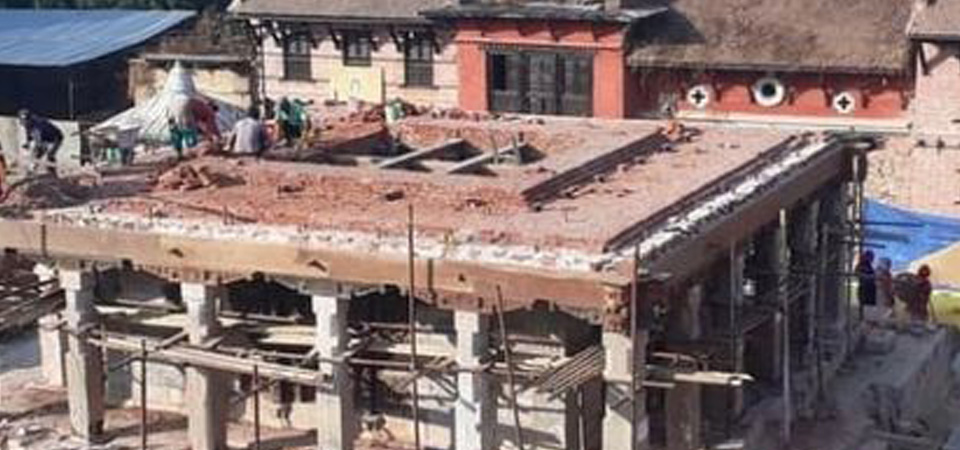Rebuilding Rato Machhindranath temple finally gaining momentum

By A Staff Reporter
Kathmandu, July 6: Reconstruction of the Rato Machhindranath temple, one of the holiest Hindu shrines in the Kathmandu Valley, has been stalled for a long time much to the dismay of local residents and devotees. Located in the quaint predominantly Newari town of Bungmati, the historic temple has been awaiting its long-overdue makeover since 2015. The devastating earthquake then had reduced several ancient monuments within the town to rubbles including the Rain God’s monument.
But construction work is finally moving at a steady pace with the Consumer Committee of Rato Macchindranath pulling up its socks to speed up the project. The committee has begun work on the temple’s second floor after rectifying the errors made by contractors earlier on the ground floor.
“We have repaired the damaged parts and have fixed parts of the doors, which were misplaced by the previous contractor,” informs Amir Shakya, chairman of the consumer’s committee. The four wooden doors of the temple have rich wooden carvings and are perceived as one of the best examples of wooden carvings in the nation. Of the four doors, only one door can be used to enter and exit the temple, the other three simply serve aesthetic purposes.
Construction work had taken a backseat during the COVID-induced restriction orders. However, during lockdown, groups of local organisations, and women’s group provided voluntary support in carrying tonnes of bricks to the temple’s second floor.
Shakya is grateful towards locals for pouring in their support. “Should there be any further assistance required, we will be happy to reach out to our capable local organisations,” he adds.
Previously funded by the Sri Lankan government, the Rato Machhindranath has had to weather several controversies over the years. Contractors have been replaced due to irregular work and use of damaged materials. Likewise, Sri Lankan government also withdrew its support in February 2020, after which the reconstruction project was handed over to the temple’s consumer committee on June 29, 2020 after reaching an agreement with the Department of Archeology (DoA). The reconstruction work, then began on July 4, 2020.
The DoA under the leadership of the National Reconstruction Authority (NRA), has been monitoring the technical aspects of the work.
Recent News

Do not make expressions casting dout on election: EC
14 Apr, 2022
CM Bhatta says may New Year 2079 BS inspire positive thinking
14 Apr, 2022
Three new cases, 44 recoveries in 24 hours
14 Apr, 2022
689 climbers of 84 teams so far acquire permits for climbing various peaks this spring season
14 Apr, 2022
How the rising cost of living crisis is impacting Nepal
14 Apr, 2022
US military confirms an interstellar meteor collided with Earth
14 Apr, 2022
Valneva Covid vaccine approved for use in UK
14 Apr, 2022
Chair Prachanda highlights need of unity among Maoist, Communist forces
14 Apr, 2022
Ranbir Kapoor and Alia Bhatt: Bollywood toasts star couple on wedding
14 Apr, 2022
President Bhandari confers decorations (Photo Feature)
14 Apr, 2022










